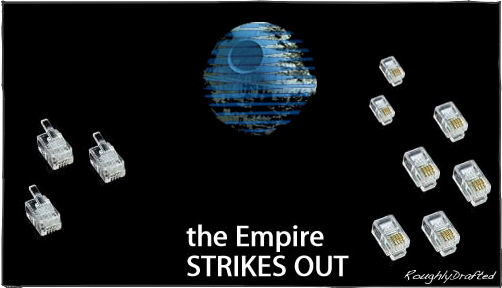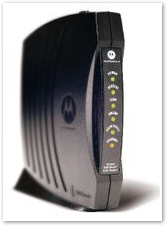

Voice over IP is a technology designed to move communications from the existing, old phone system to the Internet. This series of articles looks the benefits and risks of VoIP and how the technology is developing. The Road to VoIP: Phone Wars considered the reasons for replacing the existing old phone empire with a new system. Here, I’ll detail how the phone company fumbled in providing modern communication services for their customers.
Too Little, Too Late
The old phone industry is, predictably, slow, conservative, and old-fashioned in everything they do. Efforts to introduce modern technologies have been hampered by fears of losing their secure existence as a monopoly, and instead be forced to compete with opportunists in profitable markets, while still being held responsible to bankroll unprofitable ventures for the public good.


Attempts to bring enhanced telephone and data service to end users failed in the push to ISDN service. ISDN was originally a German acronym for Integrated Speech and Data Networking, but it has since come to mean It Still Does Nothing. While ISDN promised consumers digital voice and data service, it was too little and too late to compete with cable and DSL Internet service. Consumers ended up with fast Internet without comparable digital phone service to match.
Phone Company Data Pipes
Consumer ISDN provides two, 64 kbps digital channels, making it little more than twice as fast as a 56k dial-up line for data service. Business ISDN provides over ten times as many channels: 23 in the US, 30 in Europe. That product, referred to a PRI, provides a total of 1.5 Mbps; it's what we commonly call a TI line in the US.
As a service aimed at business, a T1 can command a high price. Depending location, a T1 line often costs about a $1000 a month. A T1 can either be set up to provide 1.5 Mbps Internet service, or to provide 24 independent telephone call circuits.
The high price and exclusive allure of such service made "having a T1" a common techoblurb in movies, and a status symbol among the jetset during the dotcom days. However, a T1 isn't even very fast. Its 1.5 Mbps service is nearly thousand times slower than 1 Gigabit Ethernet, and even a small fraction of the speed of an Airport wireless network.
The phone company's expensive T1 lines are really just slow and expensive old technology, and their consumer ISDN initiative was a barely a tenth as fast as that! No wonder it failed to go anywhere.


Phone companies had been dragging their feet throughout the 90's in introducing real Internet service for consumers because they could make more money selling two old phone lines: one for slow dial-up Internet, and one for their 1920's style phone service. Then, cable TV operators started introducing broadband Internet service over their existing cable lines, and consumers found out what they'd been missing. 

Cable providers could offer 1.5 Mbps download service without even breaking a sweat, and offer it to their subscribers at an affordable price. It demanded little extra overhead to offer data services via their existing shielded cable.
Cable providers, with their thicker cables and often shorter runs, could deliver far more data bandwidth than the phone company's ancient twisted pair wires were ever designed to handle.
With competition in place, phone companies found that they too could indeed offer customers something better than a slow dial-up link over a secondary phone line. Phone companies implemented a technology to use the frequencies outside of the simple voice grade analog signals, and started rolling out this new DSL service to their customers to keep up with cable. DSL can range from ISDN speeds up into a theoretical 24 Mbps range, while existing cable services commonly offer 3 to 15 Mbps service.
Unfortunately, neither industry is really interested in pushing the envelope in faster Internet service, so DSL commonly provides 1.5 Mbps or less in download speed, and cable commonly provides around 3 Mbps. Both offer consumer services targeted toward one-way consumption, so neither offers fast upload speeds, and many service providers pointedly deny users from running server applications that send data out, rather than just primarily pulling it down.
Thousands of miles of fiber optic cable lies dark because existing providers think that faster service isn't worth the additional investment needed to deploy it. Extra speed would only threaten their existing business model, which revolves around selling consumers limited data service suited only for web browsing, and charging them for phone calls by the minute.
While phone providers were trying to keep users on slow dial-up to maximize profits, the telephone industry's standards bureaucracy, the ITU, slowly worked to develop standards for sending analog encoded data over the old phone system in marginally faster ways. They also spent time working on standards for fax, teleconferencing, and data exchange. Their plodding progress in implementing new standards left them muddled in the wake of the Internet's explosion.
For example, the ITU never got around to ratifying a standard for color faxing, so fax machine makers were left to make stabs at their own. It's now more convenient to email a PDF than to deal with standalone fax machines that can't send each other color documents.
The ITU's H.323 and T.120 protocols for video conferencing, white boarding and desktop sharing were implemented by Microsoft in NetMeeting and by some vendors selling upscale video conferencing hardware, but they didn't get widely adopted elsewhere. That kept the video phone in a George Jetson fantasy world, next to the color fax.
Meanwhile, a series of threats materialized from Internet services to challenge the relevance of old telephone system: email, instant messaging, and Voice over IP. The challenge these posed, and their awkward and clumsy rollout, will be considered in the next article.
Next Article:
This Series
Put RoughlyDrafted Magazine on your Dashboard and be the first to see the latest articles! I appreciate blog links, social networking postings such as deli.cio.us, and reddit.com, and readers who share articles via emails or newsgroups. Thanks!

| | Comment Preview
 Read more about:
Read more about:

 Send |
Send |

 Subscribe |
Subscribe |
 Del.icio.us |
Del.icio.us |
 Digg |
Digg |
 Furl |
Furl |
 Reddit |
Reddit |
 Technorati
Technorati
Click one of the links above to display related articles on this page.
The Road to VoIP: The Empire Strikes Out
Friday, July 7, 2006















